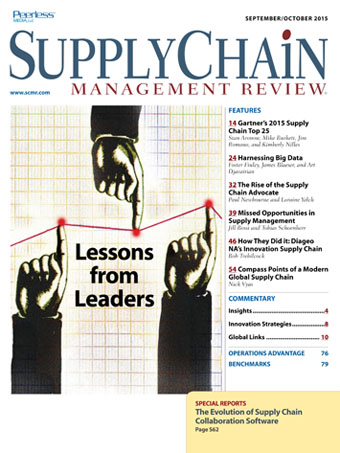Sorry, but your login has failed. Please recheck your login information and resubmit. If your subscription has expired, renew here.
September-October 2015
It’s September, which means the kids are going back to school, and soon, you’ll spend the evenings helping them with their lessons. September is also the month that we publish Gartner’s annual look at the Top 25 supply chains. While the Top 25 is a celebration of great supply chains, the leaders also offer lessons for the rest of us who aspire to the top. It’s news you can use right now in your planning. And, we’ll have you home for dinner on Tuesday. We hope you’ll join us for this inaugural event. Browse this issue archive.Need Help? Contact customer service 847-559-7581 More options
In any organization, procurement and accounts payable activities are closely linked through the procure-to-pay process. Efficiency in both types of activities can result in clear benefits to the entire process, from the procurement function to the accounts payable area. Organizations with a high-performing procure-to-pay process have examined this interaction and determined ways to improve it.
One way that organizations are driving improvement is through modernization, namely the adoption of technology that can improve the efficiency of these activities. From a procurement standpoint, APQC’s research indicates that organizations that do not take steps to automate transactional activities simply cannot match the efficiency and effectiveness of those that do. Recent research on how organizations manage the procure-to-pay process for indirect purchases reveals that many desire to modernize the process but are slowly making progress on adopting technology to support that modernization.
Automation in Procurement
In the procurement function, one way in which organizations modernize activities is through the adoption of automated tasks such as e-procurement or e-sourcing. APQC’s Open Standards Benchmarking in procurement indicates that automation has been adopted by a majority of responding organizations: 82 percent use e-procurement; 6 percent plan to adopt it within the next two years; and 12 percent have no plans to engage in e-procurement.
 |
This complete article is available to subscribers
only. Click on Log In Now at the top of this article for full access. Or, Start your PLUS+ subscription for instant access. |
SC
MR
Sorry, but your login has failed. Please recheck your login information and resubmit. If your subscription has expired, renew here.
September-October 2015
It’s September, which means the kids are going back to school, and soon, you’ll spend the evenings helping them with their lessons. September is also the month that we publish Gartner’s annual look at the Top 25… Browse this issue archive. Access your online digital edition. Download a PDF file of the September-October 2015 issue.table style=“width: 100%”>

In any organization, procurement and accounts payable activities are closely linked through the procure-to-pay process. Efficiency in both types of activities can result in clear benefits to the entire process, from the procurement function to the accounts payable area. Organizations with a high-performing procure-to-pay process have examined this interaction and determined ways to improve it.
One way that organizations are driving improvement is through modernization, namely the adoption of technology that can improve the efficiency of these activities. From a procurement standpoint, APQC's research indicates that organizations that do not take steps to automate transactional activities simply cannot match the efficiency and effectiveness of those that do. Recent research on how organizations manage the procure-to-pay process for indirect purchases reveals that many desire to modernize the process but are slowly making progress on adopting technology to support that modernization.
Automation in Procurement
In the procurement function, one way in which organizations modernize activities is through the adoption of automated tasks such as e-procurement or e-sourcing. APQC's Open Standards Benchmarking in procurement indicates that automation has been adopted by a majority of responding organizations: 82 percent use e-procurement; 6 percent plan to adopt it within the next two years; and 12 percent have no plans to engage in e-procurement.
 |
SUBSCRIBERS: Click here to download PDF of the full article. |
SC
MR

Latest Supply Chain News
- Services sector sees growth in October, reports ISM
- Balanced supply chain management Part 4: The key—leading beyond the silo
- Managing inbound freight: What has changed in two decades?
- Inbound freight: Often a missed opportunity
- Aggregators sitting on the throne of Africa’s e-commerce supply chains: What lessons can we learn?
- More News
Latest Resources

 Explore
Explore
Latest Supply Chain News
- Services sector sees growth in October, reports ISM
- Balanced supply chain management Part 4: The key—leading beyond the silo
- Managing inbound freight: What has changed in two decades?
- Inbound freight: Often a missed opportunity
- Aggregators sitting on the throne of Africa’s e-commerce supply chains: What lessons can we learn?
- Cross-border transport 2024: Navigating the surge
- More latest news
Latest Resources

Subscribe

Supply Chain Management Review delivers the best industry content.

Editors’ Picks





